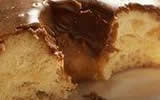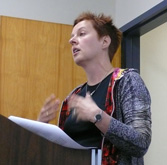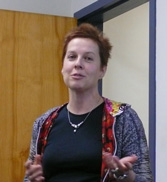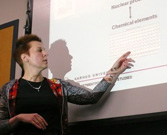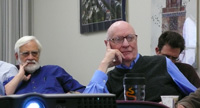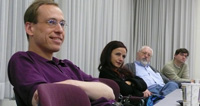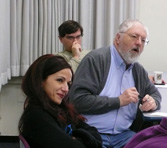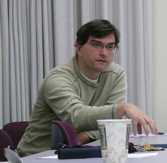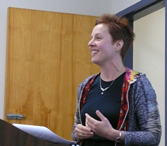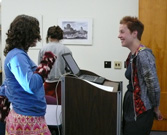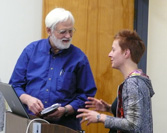::: center home >> being here >> last donut? >> andersen |
28 October 2008 Our lunchtime talks so far this term have been unusually skewed towards physical and mathematical topics. That was really an accident of the unusual number of physics-math types that had come to visit this term. As I prepared to introduce today's speaker, our Visiting Fellow, Hanne Andersen, I did not need a title or abstract to know that today would be a quite different event.
With that background, the topic of Hanne's talk seemed quite apt. It is "Interdisciplinarity." The topic, she noted, as she began speaking, has acquired some importance. The idea that disciplines should collaborate has grasped not just researchers but administrators. They are starting to set up programs explicitly designed to foster this sort of interaction. So it seems appropriate to ask the hard questions of interdisciplinarity: "When does it work well? When does it not work well?" These were questions close to my heart. My own work spans history of science and philosophy of science and I seem to drift back and forth between them. In older times that sort of commerce between the two disciplines was welcomed and encouraged. Then the History of Science Society and the Philosophy of Science Association would schedule their meetings in the same places so we could hop back and forth between the different sessions. Those days have now passed. The two societies still meet in the same venue, as they shall shortly in downtown Pittsburgh. But their programs seem to live in parallel universes with fewer and fewer bridges. Sadly, there is a growing suspicion that widens the breach between the worlds. A sense that this breach is lamentable has been behind the initiation of the &HPS series of conferences in Integrated History and Philosophy of Science and a widespread sympathy with this sense fuels the enthusiastic reception they are receiving. On other occasions, we in history and philosophy of science have benefited from the default presumption that interdisciplinary collaboration is a good thing. During my term as Chair of the Department, I had become adept at pointing out how we were one of the few Departments that understood the sensibilities of both humanists and scientists and that we could speak freely to scholars in both areas. This rather grandiose pronouncement was, I learned to my relief, never queried. It just seems to be accepted everywhere that there is an intrinsic merit in our ability to bridge disciplines. My fear had been that someone might challenge me with: "Well so what--that just makes you good at faculty cocktail parties!" How could I answer such a challenge? I knew from my own work in many examples how I had fruitfully melded science, history and philosophy. But could I mount a more principled case for the activity? For these reasons, Hanne had my attention with her questions and I settled back attentively as her story unfolded. What I really wanted to hear was a simple recipe. This is the sort of interdisciplinary activity that works; this is the sort that doesn't; and this is the formula for distinguishing them. Of course, my sort of interdisciplinary work would fall into the favored category. Surely? It was clear to me even before I formed the thoughts fully, that this was not a realistic expectation. Scholarly work is not mechanical like doing long division sums. Those recipes are not to be had and we should be very wary of someone who pretends to have them. So what did Hanne have to say? Hanne is Danish, but speaks English with a fluency and comfort that, I'm guessing, outstrips the powers of a goodly portion of the country in which English is native. Nonetheless, she announced that she was "linguistically challenged" and would read her text. I did not approve, but scowled only inwardly, for few philosophers can read papers well. I should not have scowled even inwardly since she turns out to be one of the few who can read. Her delivery was lively, punctuated with engaging hand gestures and body motions and illustrated with carefully crafted Powerpoint screens. After a while, I noticed that her linguistic challenge had evaporated and she was simply speaking directly to us. Any why not? We are a supportive audience eager to hear her account. My thoughts were with the integration of history and philosophy of science. Hanne's, it soon became clear, were not. She was concerned with the much weightier integration of different sciences. She began to call up examples in climate science, in biology and in nuclear physics. As the examples multiplied, so did the questions. Hanne's direction became clearer. She was not going to give answers to the impossible questions she'd asked. Instead she was going to map out a terrain of questions that could and should be asked about interdisciplinary collaboration. Just how do they work? How do scientists in different fields communicate? What is needed for that communication to be possible and fruitful? What sorts of things can they communicate? What sorts of common understandings can they develop? How do they negotiate disagreements? As this exploration continued, I began to see that here before us was a truly interdisciplinary analysis in its own right. This was not simple philosophy of science. Hanne herself was drawing on philosophical analysis, sociological analysis and historical analysis indiscriminately as she saw fit. This, I thought, really was a model of successful interdisciplinary research! First the find the problem, then we choose the methods that suit it, whatever they may be. On the philosophical side, there was verbiage that would make any analytic philosopher proud. I noted a long paragraph on a Powerpoint screen that began with the leaden words "A group G believes P if and only if..." Then there were brighter moments of clever philosophical self-reference. Hanne recalled a remark by Nick Rescher. In our zeal to prevent the fragmentation of science into specialties, we create yet further interdisciplinary specialties that give us more fragments. I looked down the row of faces in the room to Nick Rescher, deep in attentive thought. Then there were moments of interesting history. Her major case study was the 1930s investigation of neutron bombardment of heavy elements that eventually gave us nuclear fission. There were nuclear physicists, adept in liquid drop models of the nucleus; and there were analytic chemists, expert in the analysis of decay products. The story grew more specific historically until we heard of correspondence between Otto Hahn and Lise Meitner and their puzzling over the physically impossible but chemically incontrovertible presence of Barium. The strongest migration was to sociological analysis. It started at the familiar place with a resume of Thomas Kuhn's thoughts on disciplines. Different specialties are, supposedly, unable to communicate since they work with incommensurables. Then we moved on to more bedrock sociological questions. Just how do we identify the relevant groups in the analysis. Is it really right to say that a group knows things? Is there not a false uniformity? Are there not marginal members with peripheral commitment to the group? Should we be wary of citation as an expression of commitment? Or that a group's result published in a chemistry journal has the same commitment from a physicist in the group as when it is published in a physics journal? Hanne drew the analysis to a close and we took our customary break. I usually need to call the room to order, to herd the audience back from the bagels and donuts, so they turn their appetites to the speaker. In this case, that was not needed. I was fussing with my camera, taking snaps of people who'd come up to talk to Hanne. First Erik and then Ken Schaffner interrupted my focus to say that they wanted to ask a question when the time came. Then Peter Machamer complained that he'd not had a chance to get in the queue; and then Sandy was added. There was no stopping it. The discussion launched with gusto. John D. Norton
|

